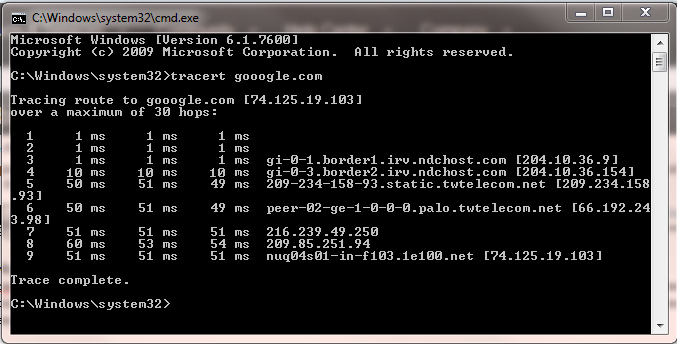Table of Contents
Testing Connectivity with Traceroute
What is Traceroute?
The traceroute utility checks how many “hops” (transfers through other routers or networked devices) it takes for your computer to reach a destination. You can use traceroute if you know the other computer's IP address, web site address, or name (e.g., 1.1.1.1, www.ndchost.com, etc).
Using Traceroute
To access traceroute on a Windows workstation, perform one of the following:
- Windows 7 or Vista: From the Start menu, in the search field, type
cmd, and then press Enter. - Previous versions: From the Start menu, select Run… . In the “Open:” box, type
cmd, and then press Enter.
At the command prompt, enter tracert yourdomain.com, where your domain is a domain name on your server or your server's IP address. This will result in something like the following (the first two host lines have been intentionally blanked):

Interpreting Results
The first column, the hop count, represents the number of stops your information has made along the route to attempt to contact the other computer. The next three columns are the round-trip times in milliseconds for three different attempts to reach the destination. The last column is the name of the host that responded to the request.
The above example shows a successful trace without any unreachable hosts. If your trace dies out after a specific hop by only returning full lines of asterisks (“* * * *”), then chances are the issue is at or just after the hop before the asterisks began.
Large jumps in response times can also mean a possible issue. If you are consistently seeing around 5ms for your first 3 hops, for example, and then on the 4th hop the response time jumps to 500ms, then there may be an issue with the 4th hop.
Sending Us the Results
In many cases, a network technician will need to analyze the problem further. To aid in this effort, you can copy the output by doing the following:
- Right click inside the command prompt window and select Mark.
- Use your cursor to highlight all of the text of the traceroute. Once you have it all highlighted, press Enter.
- This text is now on your computer's clipboard. In an email or ticket response to us, paste these results by right clicking inside the window and selecting Paste, or using the keyboard shortcut Ctrl+v.